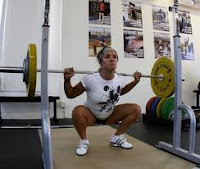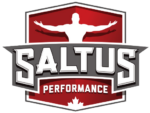BY SEAN DEL BEN, MKIN, CSCS, FMS LVL.2, FRC

Use complex training to training multiple athletic attributes simultaneously.
I have been asked many times by athletes and training enthusiasts how to best condition multiple athletic attributes (such as strength, power, speed, endurance) at the same time. So the purpose of this article is to offer an introduction to complex training. Also, whether or not it’s a viable training option for athletes with various training ages.
WHAT IS COMPLEX TRAINING?
Complex training refers to the performance of a resistance exercise immediately followed by the performance of a biomechanically similar explosive exercise (or vice versa). An example of complex training would be a loaded squat followed by a jump squat. In many athletes, this will elicit a response known as post-activation potentiation, which will essentially excite the nervous system and acutely optimize muscle force and power production more than using strength or power training on their own.
A study by Bullock & Comfort (2011) found that 5 depth jumps induced post-activation potentiation in a subsequent low volume high velocity exercise with a 6% increase in jump performance and a 4.6% increase in shot put distance. Also, this study found that if an athlete performed 2, 4 or 6 depth jumps prior to performing a low volume low velocity exercise (squats), they would see an increase 1 rep maximum performance. Likewise, resistance training can also have a positive impact on high velocity explosive movements. While Rahimi (2007) found that 2 sets of 4 repetitions at 60, 70, or 85% of 1RM for a back squat showed improvements in sprint times of 1.9, 1.77, and 2.98% respectively in well-trained athletes (capable of squatting at least 2 times body mass).
HIGH VS LOW TRAINING AGE
Not all athletes should use complex training. For the reason being that not all athletes show a strong response to this style of training. In Supertraining (Siff, 2007), complex training is historized as a method of training meant to counter monotonous workouts that only develop one physical characteristic (i.e strength, power etc.). Hence, complex training was shown to simultaneously improve the various physical characteristics needed for many sports. However, these conclusions were based on the training of athletes with a low training age. As a result, the degree of emphasis, as indicated by training volume, for each physical characteristic within complex training is not enough to witness more than average adaptations in athletes with high training ages.
BEWARE OF OVERTRAINING
In highly qualified athletes, complex training does not allow them to train with the required volume of explosive or strength based exercises to see significant results. Certainly, a highly qualified athlete could attempt to use a complex training regime with the volume necessary for sufficient adaptation in each individual athletic attribute. However, they would be putting themselves at risk for burn out and injury via overtraining.
Separating GPP & SPP for the Highly Qualified Athlete
Key Terms:
*General Physical Preparation (GPP) = Refers to balanced conditioning in endurance, strength, speed, flexibility and other basic factors of fitness. In regards to the topic of this article, it would refer to the goal of improving ones strength via an exercise such as a squat.
*Special Physical Preparation (SPP) = Refers to exercises which are more specific to the particular sport. In regards to the topic of this article, it would refer to the ability to display a high rate of force production with an explosive exercise such as a plyometric.
Please note that the GPP and SPP are still interconnected and involve much more depth and understanding than the scope of this article aims to provide.
*Unidirectional Loading = Training cycles (daily, micro, meso, macro) devoted to the development of a single athletic characteristic.
NEXT UP…
I have discussed why complex training is not an effective training protocol for highly qualified athletes. As such, I will outline basic periodization schemes with a goal of improving both GPP and SPP. Prolonged unidirectional loading, such as for strength or power, will result in the development of only one physical characteristic. This will potentially leave the athlete ill-prepared for the demands of their sport.
UNIDIRECTIONAL LOADING
Unidirectional loading can be effective in mesocycles lasting from 4 to 12 weeks (Siff, 2004). It may also be effective for highly qualified athletes to interchangeably train physical characteristics from microcycle to microcycle. Swimmers who have trained speed and endurance interchangeably from microcycle to microcycle have displayed significant adaptation (Siff, 2004). Furthermore, microcyles focused solely on strength training have significantly contributed to the SPP of track and field jumpers (Siff, 2004).
Some strength coaches advocate using complex training mid-season as a way of maintaining all athletic characteristics throughout the season when the availability of training time is scarce. Consequently, it is important to monitor the performance of your athletes both in the weight room and in their respective sports if the athlete is currently using a complex training program.
CONSIDER SEPARATE MICROCYCLES
With input from the sport coach, determine if the athlete possesses enough special sport preparation to maximize their performance. If their sport performance is not where it should be, and you are dealing with a highly qualified athlete, it may be time to consider training strength, speed, power, or endurance in separate microcycles. However, during the off-season it is preferable to train an athletic attribute in separate mesocycles for a minimum of four weeks. Typically, an athlete is not looking for special preparation until a month prior to the season commencing (in team sports). Therefore, they should spend a longer period of time focusing on their weak points. Athletes who require a much more significant boost in a single attribute may need to use unidirectional loading for up to twelve weeks.
TO CONCLUDE:
• Coaches and athletes should use discretion when prescribing and using complex training
• Complex training may be an effective training protocol mid-season in order to maintain all-athletic attributes with limited training time
• Highly qualified athletes may not notice substantial training adaptations from using resistance and explosive exercises in the same training session
• Unidirectional loading for separate athletic attributes may successfully be used interchangeably from microcycle to microcycle (week to week), from mesocycle to mesocycle (month to month), or every three months
There are many different periodization schemes in existence, and many of them may be effective for your athletes. Hence, this brief write up is meant to give you an introduction to complex training. Further, it should create awareness regarding the options available to train the multiple athletic attributes required in many team sports.

